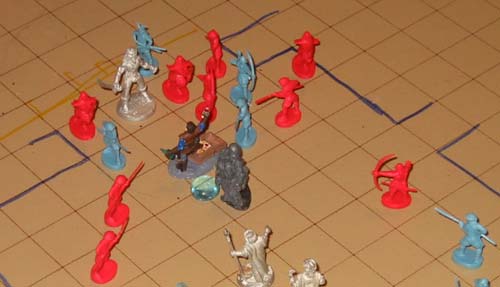Obergnom
First Post
I am looking for good Mook/Minion houserules for 3.5.
You know, the kind of rules that removes the bookkeeping (even at 10th level some characters manage not to do so much damage a low level creature like an oger dies with a single hit) and allows me to use them "en masse" without a resolution time problem.
Recent situation: A challenged my party with rylkar (MM5 ratlike creatures)... I do not have my book with me, but the weaker ones basicaly have a lot of attacks (3) that were unable to hit exept when rolling a nat 20.
Aiding another was possible, but somehow unreasonable (the were kind of enraged) and boring.
Thinking about it, players have a lot of AC but few HP compared to monsters. Thus a first rule could be to allow some kind of inverse power attack for monsters. Reduce the damage by 5, get +5 to hit. (It is a DMs tool, one shuold not abuse it for unlimited damage in combination with power attack for 2-handed weapons)
Reducing the number of attacks and adding further +2 to hit might also help.
I was really suprised by the way the encounter worked out... it was kind of boring, the players AC did not matter (a 20 is a hit, no matter if your AC is 24 or 32), I was rolling many d20 which again takes some time, and the creatures have just enough HP to be able to stand the single attacks most of my players were able to make.
what are your mook rules or tricks to make such encounters more fun and less work? I wing a lot of my sessions and sometimes I just feel like "Hey, they could encounter an orc tribe right now..."
You know, the kind of rules that removes the bookkeeping (even at 10th level some characters manage not to do so much damage a low level creature like an oger dies with a single hit) and allows me to use them "en masse" without a resolution time problem.
Recent situation: A challenged my party with rylkar (MM5 ratlike creatures)... I do not have my book with me, but the weaker ones basicaly have a lot of attacks (3) that were unable to hit exept when rolling a nat 20.
Aiding another was possible, but somehow unreasonable (the were kind of enraged) and boring.
Thinking about it, players have a lot of AC but few HP compared to monsters. Thus a first rule could be to allow some kind of inverse power attack for monsters. Reduce the damage by 5, get +5 to hit. (It is a DMs tool, one shuold not abuse it for unlimited damage in combination with power attack for 2-handed weapons)
Reducing the number of attacks and adding further +2 to hit might also help.
I was really suprised by the way the encounter worked out... it was kind of boring, the players AC did not matter (a 20 is a hit, no matter if your AC is 24 or 32), I was rolling many d20 which again takes some time, and the creatures have just enough HP to be able to stand the single attacks most of my players were able to make.
what are your mook rules or tricks to make such encounters more fun and less work? I wing a lot of my sessions and sometimes I just feel like "Hey, they could encounter an orc tribe right now..."

